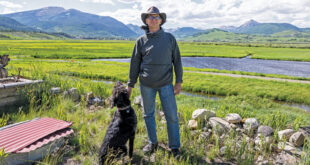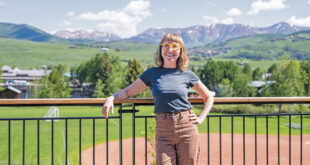A True American Tale
“They said that was my name. I was there when they named me but I don’t remember it,” Coot Nelson grins, knowing you’re easy prey for his well-planned jokes.
“They used to call me Coot but now they call me old Coot,” he claims but “old” doesn’t fit this nonagenarian with the boyish grin and sharp wit who’s still vigorously mowing his own lawn. “I’ve survived two plane crashes in the service, being shot at by the Japanese in World War II, two car crashes where the cars were totaled, and one dog attack while retrieving my mail outside my house at Crested Butte,” says the man with nine decades behind him, still laughing heartily about life.
When asked about his longevity and spryness, Coot answers, “I never was this old before. I don’t know how I’m supposed to feel. I don’t think about my age. When I get old I might think about it. Today is the oldest you’ve ever been, and the youngest you’ll ever be.”
Coot was born in Madill, Okla. His father died in the flu pandemic of 1918, six months before he was born in May 1919. They were farmers, mostly growing cotton. “I was the fourth child, so my mother was left with a daughter, two sons and me on the way,” Coot tells. “Couple of years later, she married a man with five kids, and then they had six more.” Yes, you counted correctly …that’s 15 kids. Coot chuckles, “We had company without leaving home.”
Their house was not big but modest, and he recalls the average day in the life of a farm boy with 14 siblings. “We worked all the time. We were on the farm sun up to sun down, working with horses and mules, no tractors, no electricity. Farmers didn’t have electricity in Oklahoma until 1939, until the co-ops came in.”
Despite long hours of labor, Coot swears he never missed school. “I lived nine and a half miles from school and rode the bus, but because of athletics, sometimes you had to walk home. I did football and wrestling,” and that’s wrasslin’, mind you.
In his senior year of high school, Coot stayed in town working in a restaurant. “I washed dishes and slept in a little 10 by 10 wash house.
I had a cot in there.” He graduated in 1937 and a “wrasslin’” scholarship got him into Southwestern Teachers College, in Weatherford, Okla.
“You had to work for 25 cents an hour for your room, board and tuition. That was your scholarship,” he says of the work-study program and adds that you were fortunate to get this sort of a scholarship, “because there was no place for a guy to work [in Weatherford]. I worked in a restaurant downtown for my meals and had to work three hours a day for three meals and then work janitor and carpenter work at the college for tuition and room.”
Taking mathematics and shop/woodworks, Coot received his teacher’s degree and headed straight for the Navy. “I went into the Navy flight training program …one month and one day before Pearl Harbor was bombed on December 7, 1941. I got my wings after I transferred to the Marines August 1942.”
In a 1942 midnight flight training for night flying practice, Coot was supposed to rendezvous with his instructor at 1,500 feet, but at 700 feet his plane started cutting out and losing power. “The flight tower didn’t answer. They had a remote that was supposed to take over. I was coming in high and here comes a plane taking off towards me. I had to land in the boondocks parallel to the runway, but I hit a mud hole and it flipped the plane and broke the plane in two. So far, I’ve survived that,” he smiles.
During World War II, Coot flew the Douglass Dauntless Divebomber. “I was sent to Guadalcanal, bombing Japanese shipping and airfields, anywhere they had guns. We supported the ground troops when they were trying to take over the islands in main advancing movement.” Guadalcanal, a tropical island in the southwest Pacific, became a major turning point in WWII as it stopped Japanese expansion. After six months of fighting, the Japanese gave up control of the island.
Coot tells of his Bougainville service during the war. “Our troops were making a landing. There were five of us, each had a smoke bomb.” He explains what the pilots’ mission was. “When you’re down on the boats, in the barges, you can’t see very good. They were gonna land in five different landing places and the smoke gave them a point to land,” Coot says of the visual aid his flight provided and added that Bougainville was a hot place, meaning, it was a major theater in the war.
The Bougainville Campaign was also called Operation Cherry Blossom, and was fought by the Allies in the South Pacific to regain control from the Japanese, who had constructed multiple naval aircraft bases on the island, which is part of Solomon Island chain to Guadalcanal.
After the Guadalcanal victory, the Allies advanced up the Solomon Chain and began the Bougainville campaign as part of the larger Operation Cartwheel. The Allied campaign began on November 1, 1943 and ended on August 21, 1945 with the surrender of the Japanese.
“The first six months I was out there [Bougainville], I didn’t get one bullet hole in my plane but the last six months I was shot about every time I went out. The next day they shot me down. That was ‘43,” Coot remembers. “I still have the shrapnel. It hit the gasoline line and went a third of the way in and stuck. Had it gone another half inch it would have severed the line. The plane cut out and I switched on my booster pump, got enough power force to push gas. I made it half way back home and landed on the beach. They put a new hose in and they sent me on to my base.” Coot tells the story today with a matter-of-fact humor but not belying the true horrors of war.
“In 1945, my first carrier landing ended up being a crash landing. I was in the first set of planes that went out and I was the first one to come in. The signaler brought me in too high …we called him Hollywood Johnson because he went through so many motions. The tail hook of the plane missed all the cables and went through the barrier, then it set me up on my nose. They had a different way of landing, other than that,” Coot’s mischievous eyes sparkle. “This all happened one evening. The next day we broke the Navy’s record by making 602 carrier take-offs and landings.”
We are sitting outside as he tells his stories. Coot gets up from his chair and motions for me to ring a large iron bell hanging from a post on the edge of his deck. “Just give that rope a pull,” he winks. In less than a minute, half the residents of Sopris Avenue, some with drinks in hand, arrive with Coot spryly making a continuous run to his wine rack for the rest of us. Bowls of nuts and Chex mix are passed around. Like a parade, more neighbors trickle in and out. The story of his 94 years continues through the cacophonous chatter.
“I got back from overseas on Christmas Day 1943 for a month,” Coot sets the stage. He met his wife, Bette Dietrich, in college, but they never dated. “We had started writing while I was overseas, not talking about marriage until Christmas Day. She wouldn’t let me go home until I asked her to get married. I asked when, she said next Saturday night, New Year’s Day.” And so they got hitched and the newspapers announced that he dived-bombed his way into marital bliss, but he jests, “They said it wouldn’t last, so we said it was temporary …we were temporarily married for 62 years.”
The couple produced a houseful of four kids, the youngest of which were twin boys and after getting out of the service at the end of the war, they moved to southern California so Coot could attend optometry school. The family then returned home to Watango, Okla., where Coot had his practice for 37 years before retiring in 1984. Bette passed away two years ago. But the couple wound up in Crested Butte through Bette’s sister.
Coot explains, “Their son went to Western State College. He bought the St. Patrick’s parsonage in 1968 so we came up that summer. Hippies everywhere, dusty roads, no pavement… anybody who would invest here is out of their cotton pickin’ mind!” he exclaimed, but he and Bette came every summer after that, and bought their home here in 1978, spending the cooler summers in joyful happy hours on their deck.
“It’s the five o’clock seminar,” he says of the daily happy hours. “You get a good education with the melting pot of Crested Butte… Crested Butte is the world. I just get up in the morning and go to bed at night. Just live one day at a time, ‘cause yesterday’s gone and tomorrow might not be here. Every hour is a happy hour.”
He plans on continuing his summer return to Crested Butte because, he claims, “Where else can I have more fun? It’s a good friendly place, everybody is on the same level and you can just speak to people. It’s amazing what a cross-section of the world you meet here in Crested Butte. All these neighbors have a story. I get a kick out of walking down the street meeting people, asking where they’re from. People here have a good time. That’s what I’m here for… to enjoy life.”
 The Crested Butte News Serving the Gunnison Valley since 1999
The Crested Butte News Serving the Gunnison Valley since 1999




